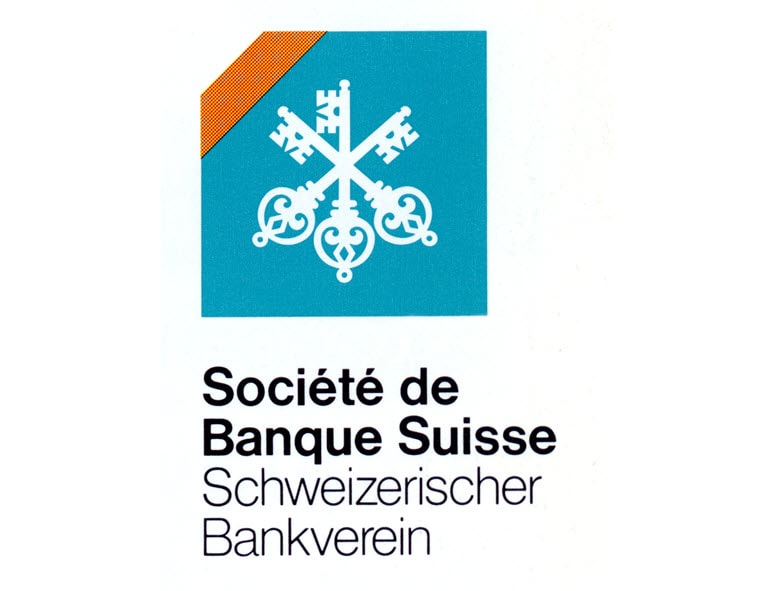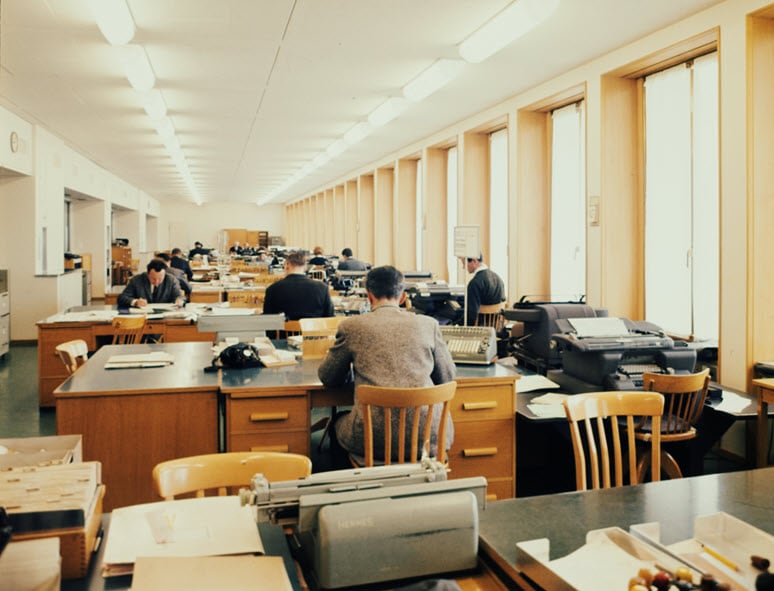UBS Virtual Museum
1922-1960
1922
A revolution in accounting
Prior to the introduction of the accounting machine, all accounting was done by hand, using pen and ink on bound, heavy books. Both Union Bank of Switzerland and Swiss Bank Corporation (SBC) experienced the wave of automation at the same time in 1922. The fiche system (card indexing), which was introduced along with the technological advancement of the accounting machine, allowed bookkeeping to be done on loose sheets. Over the following ten years, this caused the accounting department’s output to more than double.
1930
Swiss Bank Corporation offices at the Zurich stock exchange
As one of the most significant stock exchange banks, Swiss Bank Corporation (SBC) already had a stock exchange room in the magnificent, historic former Zurich Stock Exchange building at Bahnhofstrasse 3. Dealers could place orders “à la criée” in the trading ring while taking orders from clients over the phone. In 1928, work on building a new stock exchange began, due to the increasingly congested conditions and the antiquated technical infrastructure. SBC also had a separate exchange room, located just a few steps away from the trading rings.
1938
Three keys for Swiss Bank Corporation
UBS without the three-keys logo? Unimaginable! The three crossed keys without the UBS lettering are equally unthinkable. These two components have combined to create the distinctive UBS logo since 1998. The three keys, however, are about 60 years older: prior to the 1998 merger, they belonged to Swiss Bank Corporation (SBC).
1939
Turbulent years at the New York branch office
Swiss Bank Corporation (SBC) made a number of attempts after its founding aimed at establishing itself in the “new world of unlimited opportunities.” As the North American region grew in economic importance and there were more and more trouble spots in Europe, SBC decided toward the end of the 1930s to open a branch office in New York. More specifically, it opened its office on 4 July 1939, at 15 Nassau Street, close to the stock exchange. SBC hoped that the New York office would develop in a similar fashion to the London office, which had enjoyed a successful track record since 1898. The State of New York’s banking department gave its approval for the office’s transformation into a full branch in 1963.
1944
Union Bank of Switzerland Takes Over Creditanstalt in Lucerne
Union Bank of Switzerland expanded its presence in central Switzerland by acquiring Creditanstalt in Lucerne (founded in 1872). Nearly another 20 years elapsed before SBC opened its first location in the city of lights, a branch which started its operations in 1963.
Today, the UBS Lucerne branch is located on Bahnhofplatz. The first premises of its predecessor were located on Kapellplatz and later on Schwanenplatz.
1947
Introduction of punched-card technology
Punched cards for mechanical data processing were first used in the US census in 1890. Almost 50 years were to pass before the technology developed by American engineer Herman Hollerith made the leap across the Atlantic, where it was deployed for data collection and storage by our two predecessor institutions, Swiss Bank Corporation (SBC) and Union Bank of Switzerland. The first transition involved only mechanization; for internal use, the results of entries and accounts were punched, checked, and stacked. Our predecessor banks then gradually replaced traditional account books with their first machine-readable data storage.
1956
The bank’s first computer
With the commissioning of the UNIVAC 120 type from Remington Rand at the start of 1956, Union Bank of Switzerland entered the computer era. The 1,400-kilogram machine’s programmability, mastery of the four fundamental functions and ability to electrically buffer outcomes made it revolutionary. It was capable of handling both the calculation of deposit balances and coupon settlements, and it did so much faster than its mechanical predecessors. However, each operation was recalculated backward for control reasons. With an order for the IBM 1401/7070 five years later, SBC also ushered in the era of electronic data processing.
1958
The drive-in bank
In the 1950s, cars became synonymous with progress and the economic boom, but that wasn’t all: they were also the pride of the whole family. Everything had to be reachable from inside the vehicle, ideally from the driver’s seat. Union Bank of Switzerland opening Switzerland’s first drive-in counter, at its Zurich Wiedikon city branch, in June 1958 generated a huge buzz. However, the drive-in bank proved to be only a fleeting success, unlike the cash dispensers (ATMs) introduced some years later. The last drive-in bank branch had closed by the early 1980s.
1960
Opening of the new Swiss Bank Corporation building on Paradeplatz
After a period of construction lasting more than ten years, on 23 June 1960 Swiss Bank Corporation officially opened its new office on Paradeplatz. As long ago as the early 1930s the bank had run a competition for ideas for extending this office, or even building an entirely new one, in which 14 architects’ practices had participated. The winner was Otto Rudolf Salvisberg, Professor of Architecture at ETH Zurich. His work showed that only a new building could meet all the requirements. However, due to the depression, the outbreak of World War II and the resulting shortage of building materials, the actual construction project was delayed by decades. Since Otto R. Salvisberg died long before construction could begin, his son-in-law Roland Rohn took over the job of finalizing the plans. Among other things, he was responsible for the Modernist, now listed, façade.
1960
Rapid expansion abroad
In the post-war years between 1945 and 1959, the total assets of Swiss Bank Corporation increased steadily, from CHF 1.8 billion to CHF 4.3 billion. But the pace of development was to accelerate significantly around 1960. In just 10 years, between 1960 and 1970, Swiss Bank Corporation’s total assets grew more than fivefold – from CHF 5.2 billion to CHF 28.1 billion francs. This growth was primarily down to two factors. First, increased trade with the newly rebuilt Europe brought Switzerland, undamaged as it was, an unprecedented economic boom that continued uninterrupted until the first oil crisis, in 1973. This boom contributed to substantial deposit inflows and growing demand for credit. Secondly, at the international level the creation of the European money market and capital markets facilitated the expansion of financial markets.























































